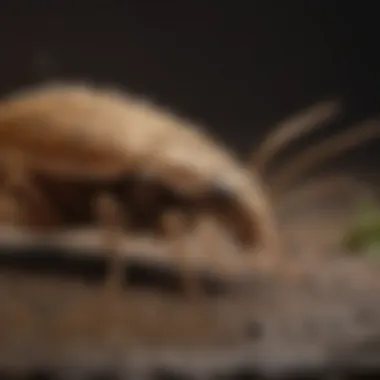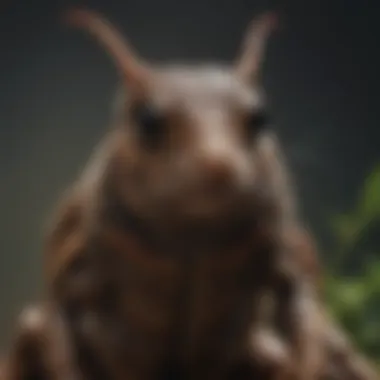Comprehensive Guide to Exterminator Services


Intro
Pest control is a vital service that addresses various issues in homes and gardens. Understanding the nature of pests, their habits, and the available extermination methods is crucial for effective pest management. This guide offers a detailed exploration of exterminator services available in Springfield, IL. Each section is crafted to support homeowners and engage anyone seeking effective pest management solutions.
Understanding Pests
Definition of Pests
Pests are organisms that cause harm to human health, property, or the environment. They can be insects, rodents, or plants that disrupt the natural balance in a given area. Common examples include ants, termites, rats, and weeds. Understanding what qualifies as a pest is the first step in effective pest management.
Importance of Pest Identification
Identifying the specific type of pest is crucial for a successful extermination strategy. Different pests require unique approaches for effective control. For instance, the methods used to control termites differ significantly from strategies used for controlling cockroaches. Correct identification helps avoid unnecessary treatments and ensures the selection of the most efficient extermination methods.
Prelude to Pest Control Services
The need for pest control services arises from the realities of living in a world shared with various pests. In Springfield, Illinois, homeowners face a variety of challenges related to rodents, insects, and other unwanted creatures. Effective pest management is essential not only for comfort but also for health and property preservation. When pest populations grow unchecked, they can lead to significant damage and potential health hazards.
Overview of Extermination
Extermination is the process of removing or eliminating pests from a designated area. It normally involves various methods depending on the type of pest and the severity of the infestation. Understanding the techniques available is crucial. For instance, common methods include chemical treatments, physical traps, and eco-friendly approaches. Each method has its own set of advantages and drawbacks. chemical treatments may provide quick results but carry potential risks for humans and pets. Physical traps tend to be less hazardous but may require ongoing maintenance. Eco-friendly approaches prioritize safety but might offer slower results.
It’s essential to evaluate the best course of action for each specific situation. Homeowners should consider factors such as the nature of the pest, the location of the infestation, and their own preferences for sustainability.
Importance of Professional Services
Engaging professional extermination services is paramount for several reasons. First, professionals possess the qualifications and experience to correctly identify pests and their patterns. This is not always easy for an average homeowner to discern. Misidentification can result in ineffective treatment plans, leading to wasting time and money.
Second, professional exterminators are trained in pest control techniques that adhere to safety regulations. They know how to apply chemicals safely, ensuring minimal exposure for humans and pets. Furthermore, they can provide lasting solutions rather than temporary fixes.
Lastly, hiring experts can save homeowners from stress and frustration. The DIY approach may seem appealing, but it often leads to complications. Professionals handle the logistics, allowing homeowners to focus on their daily lives without dealing with pest nights. Therefore, the decision to employ professional services boils down to safety, effectiveness, and peace of mind.
Professional pest control can lead to long-term benefits, including better health standards and property value preservation.
Common Pests in Springfield,
Understanding the common pests in Springfield, IL, is crucial for effective pest management. Each type of pest poses unique challenges, risks, and issues that can affect homeowners significantly. Recognizing these pests helps in identifying the right prevention and extermination strategies. Homeowners should become familiar with these creatures as early detection can lead to less severe infestations and lower extermination costs.
Rodents
Rodents are a common concern for many households in Springfield. Not only do they spread disease, but they also cause physical damage. Common species include Norway rats and house mice.
Rodents can easily enter homes through small gaps and holes, making it essential to conduct regular inspections. They reproduce quickly, which means a small problem can escalate into a larger one swiftly. To prevent infestations, it is important to store food securely and ensure that all entry points are sealed. Homeowners should also consider setting traps or consulting an exterminator to address any existing rodent issues effectively.
Termites
Termites are often called the "silent destroyers." They can cause extensive structural damage before a homeowner even realizes they are present. These pests feed on cellulose found in wood, paper, and other organic materials.
In Springfield, subterranean termites are particularly prevalent. They typically live underground and can access a home through cracks in the foundation. To protect against these pests, homeowners should routinely check for signs of termite activity, such as mud tubes or hollow-sounding wood. Early intervention is key, so consider professional inspections if you suspect a problem.
Ants


Ants are a common nuisance in homes across Springfield. Types such as carpenter ants and Argentine ants can invade kitchens and pantries, searching for food and water. While they may seem harmless, some species, like carpenter ants, can damage wooden structures.
To deal with ants, it's crucial to locate and eliminate the source of the infestation. Keeping food sealed and cleaning up spills can help deter them. If infestations persist, the engagement of an exterminator may be necessary to eliminate the colony effectively.
Bed Bugs
Bed bugs are a growing concern in many urban areas, including Springfield. These pests are small, reddish-brown insects that feed on human blood. They are notorious for infesting bedding, mattresses, and furniture.
While bed bugs do not transmit any diseases, their bites can cause discomfort and lead to sleep disturbances. Detection can be challenging, as they often hide in tiny crevices. Signs of an infestation include the appearance of small blood stains or dark spots on bedding. Homeowners who suspect a bed bug problem should act quickly and consult pest control professionals who have proven bed bug eradication methods.
Extermination Methods
The choice of extermination methods plays a crucial role in effective pest control. Understanding the various types of methods available can help homeowners in Springfield, IL, choose the right approach for their needs. The effectiveness, safety, and environmental impact of these methods are significant considerations. Selecting the proper extermination method can lead to not only immediate relief from pests but also long-term prevention. This section delves into three primary types of extermination methods: chemical treatments, physical and mechanical solutions, and eco-friendly approaches.
Chemical Treatments
Chemical treatments are one of the most commonly used methods in pest control. These treatments generally involve the use of pesticides and insecticides specifically designed to eliminate pests. They can be effective for a variety of pest types, including insects like ants and termites. However, the choice of chemical treatment should be approached with caution. Homeowners should consider the potential health risks to humans and pets, as some chemicals can cause irritation or more severe health effects.
- Effectiveness: Pesticides can quickly reduce pest populations.
- Types: Various types of pesticides are tailored to specific pests. For example, insecticides for termites differ from those for ants.
- Regulations: Homeowners must follow local regulations regarding pesticide usage, ensuring that substances used do not pose unacceptable risk to the environment.
Safety precautions are essential: Always read labels carefully and follow instructions to minimize risks associated with chemical exposure.
Physical and Mechanical Solutions
Physical and mechanical solutions encompass a range of strategies that do not rely on chemicals. These methods often focus on removal and exclusion techniques. Such approaches are vital in a holistic pest control strategy.
- Traps: Using traps is a straightforward method to capture rodents and other pests. Different traps serve different purposes, with some designed for catch-and-release and others for elimination.
- Sealing Entry Points: A critical factor in pest management is sealing openings in homes. This can include gaps around windows, doors, and foundations.
- Environment Control: Adjusting the environment to make it less hospitable to pests can effectively reduce infestations.
These methods are generally safer for household members, including pets, as they typically do not involve toxic substances.
Eco-Friendly Approaches
Increasing awareness of environmental issues has led to a growing interest in eco-friendly pest control practices. Many homeowners seek methods that minimize harm to ecosystems while still effectively managing pests.
- Natural Remedies: Many people use natural substances like diatomaceous earth or essential oils to deter pests without harmful chemicals.
- Biodiversity: Encouraging natural predators can help reduce pest populations effectively. For example, introducing ladybugs can manage aphid problems in gardens.
- Biological Control: This involves using living organisms, such as beneficial nematodes, to target specific pests. It is an effective long-term solution when managed correctly.
Remember: Choosing eco-friendly approaches not only benefits the immediate environment but can also improve the overall health of your home.
Selecting a Reliable Exterminator
Choosing a reliable exterminator is a pivotal decision for homeowners facing pest problems. The effectiveness of pest management directly correlates with the expertise of the exterminator. A skilled professional not only eradicates pests but also addresses underlying issues that could lead to future infestations. Trustworthy service ensures that treatments are safe for both family members and pets. Therefore, homeowners must carefully evaluate their options when selecting an extermination service.
Factors to Consider
When searching for an exterminator, several factors should be taken into account. First, assess the experience of the exterminator. An established company often has a proven track record, indicating reliability and expertise. Also, inquire about the types of pests treated; some exterminators specialize in specific areas, while others offer more comprehensive services.
Next, consider the methods employed by the exterminator. Are they using eco-friendly options? Some homeowners prefer these methods to reduce environmental impact and ensure safety. Understanding the range of techniques available can help in making an informed decision.
Finally, pricing should not be ignored. While it may be tempting to go for the cheapest option, balance efficiency and cost. High-quality service generally reflects a fair price.
Credentials and Certifications


Verification of credentials and certifications is crucial when selecting an exterminator. Many states require pest control professionals to hold licenses. These licenses ensure that the exterminator has received proper training and understands regulations. Additionally, look for certifications from recognized bodies, such as the National Pest Management Association. These credentials indicate a commitment to professionalism and continual learning in the field.
An exterminator with the right certifications can provide peace of mind to homeowners. You can be assured they are knowledgeable about the latest techniques and safety protocols in pest control.
Client Reviews and Testimonials
Client reviews and testimonials serve as valuable resources in the decision-making process. They provide insight into the exterminator's reputation and the satisfaction level of previous clients. Check online platforms where reviews are posted, like Facebook or Reddit.
Positive feedback often highlights effective service, timely responses, and thorough follow-up. Conversely, negative reviews can reveal potential issues that may be deal-breakers. When reading through reviews, pay attention to recurring themes; if multiple clients mention the same strengths or weaknesses, these deserve consideration.
"A trustworthy exterminator does not just eliminate pests but also educates the homeowner on preventative measures for future."
In summary, selecting a reliable exterminator requires careful consideration of multiple factors: experience, methods, credentials, and client feedback. Such a comprehensive approach ultimately leads to more effective pest control, ensuring your home remains safe and comfortable.
Cost of Extermination Services
Understanding the cost of extermination services is critical for homeowners in Springfield, IL. This knowledge not only helps residents budget for pest control but also enables them to value the services they receive. Pest infestations can be disruptive, leading to potential damage and health risks. Therefore, evaluating the cost of extermination is not just a matter of expense but a crucial step in maintaining a safe and comfortable home.
Factors Influencing Cost
Several factors can affect the overall costs associated with extermination services. These include:
- Type of Pest: Different pests require different treatment techniques. For instance, termites may need specialized solutions compared to general insects like ants or roaches.
- Severity of Infestation: The extent of the infestation influences the cost. A minor pest problem might require only a local treatment, while a severe infestation could necessitate extensive measures.
- Size of Property: The square footage of a home can directly relate to the cost. Larger homes may incur higher fees due to the increased amount of pest control products or time required for treatments.
- Treatment Methods: Some extermination methods are more complex and time-consuming than others. Chemical treatments might be more affordable than eco-friendly options or physical removals, affecting the total price.
- Frequency of Service: One-time visits tend to be different in pricing as compared to bundled services that provide ongoing treatments. Regular maintenance can mitigate costs over time.
By understanding these factors, homeowners can make informed decisions when selecting an extermination service.
Average Pricing in Springfield
In Springfield, IL, the average cost of extermination services can vary significantly based on the factors discussed. Generally, prices can range as follows:
- Single Treatment for General Pests: Costs typically range from $150 to $300. The lower end of this spectrum applies to minor infestations, while more significant issues may warrant higher fees.
- Termite Inspection and Treatment: Because of their potential for damage, termites pose special pricing considerations. Inspections alone can range from $75 to $200, with treatment costs potentially exceeding $1,000 based on severity.
- Monthly Maintenance Plans: Many companies offer ongoing service agreements. These plans often average about $40 to $70 per month, depending on the level of service and frequency.
Homeowners should seek quotes from multiple service providers to ensure they are receiving competitive pricing for the services required.
"Being informed about the cost and factors that influence extermination services is essential for responsible pest management".
Preventative Measures for Homeowners
Preventative measures are an essential part of pest control strategy. Homeowners must understand that proactive steps can significantly reduce the likelihood of infestations. Taking precautions not only protects homes but also promotes a sustainable living environment. Small actions can lead to substantial improvements in pest management.
Sealing Entry Points
One of the most effective preventative measures involves sealing potential entry points. Pests, such as rodents and insects, can enter homes through the tiniest cracks and holes. Common places to inspect include windows, doors, and any gaps in walls. Owners should use caulk or weatherstripping to seal these areas. Regular inspections can catch openings before they become pathways for pests.
- Inspect regularly for visible cracks.
- Use caulk for small holes and gaps.
- Install door sweeps to block openings.
By sealing entry points, homeowners can significantly lower pest activity inside their homes.
Proper Waste Management
Effective waste management is another key element in pest prevention. Pests are often attracted to the availability of food and shelter. Homeowners need to manage waste properly, which includes securing garbage bins and compost piles.


Here are some strategies to consider:
- Keep trash cans covered: Use bins with tight-fitting lids.
- Dispose of food waste quickly: Compost or discard leftovers immediately.
- Clean regularly: Ensure that surfaces are free from crumbs and spills.
Inadequate waste disposal can invite various unwanted pests. By managing waste, homeowners decrease the appeal of their homes to scavengers and insects.
Landscaping Considerations
Landscaping should not be overlooked when it comes to pest prevention. Design choices can either attract or deter pests. Proper landscaping can serve as a barrier against visits from unwanted creatures.
Key considerations include:
- Maintain vegetation: Trim shrubs and bushes regularly.
- Mulch wisely: Use materials that do not attract pests, like cedar mulch.
- Avoid overwatering: Standing water attracts mosquitoes and other insects.
An appealing landscape can enhance a home’s value while also helping to reduce pest presence. By considering these aspects, homeowners can create an environment resistant to infestations.
"Prevention is always better than cure." It applies not only to health but also to pest management in the home.
Implementing preventative measures requires effort, but the results can lead to a pest-free home. By sealing entry points, managing waste effectively, and being mindful of landscaping, homeowners can protect their living spaces from undesirable pests.
Regulatory Considerations in Pest Control
Pest control is not only about eliminating unwanted pests from residential and commercial properties. It also involves adhering to regulatory frameworks that govern how this is accomplished. Understanding these regulations is essential to ensure that pest control services are effective and safe.
Local Regulations
Local regulations vary by state and municipality in Springfield, IL. These regulations can dictate how extermination procedures must be conducted, which chemicals can be used, and what safety precautions must be taken. Homeowners must be aware of the following key aspects:
- Licensing: Exterminators should hold valid licenses that demonstrate their qualifications. This helps ensure that they meet the necessary standards set by the state.
- Chemical Use: Certain pesticides may be banned or restricted in Springfield. Homeowners should inquire about the chemicals being used and ensure they comply with local regulations.
- Notification Requirements: Some municipalities require homeowners to be notified before treatments occur. Knowing this can aid homeowners in planning appropriately for treatment days.
Being informed about local regulations can help homeowners avoid legal issues and ensure that pest control efforts do not inadvertently harm themselves or the environment.
Environmental Impact Assessments
Environmental Impact Assessments (EIAs) are critical tools for evaluating the potential effects of pest control activities. These assessments consider how extermination methods, particularly chemical treatments, may affect local ecosystems. Here are some important points regarding EIAs:
- Assessment Process: An EIA usually starts with an analysis of the area where pest control will take place. It examines the surrounding environment, including soil, water, and non-target organisms that could be affected by pest management practices.
- Long-Term Effects: These assessments consider not only immediate impacts but also long-term ecological consequences. This could include biodiversity loss, soil degradation, or water contamination.
- Community Awareness: Residents benefit from understanding the potential environmental impacts of pest control. Sound communication from pest control companies regarding their assessment results fosters transparency and safety.
"Proper assessments ensure that pest control methods chosen will lead to effective pest management without compromising environmental integrity."
In summary, regulatory considerations play a fundamental role in pest control strategies in Springfield, IL. Both local regulations and environmental impact assessments guide practices that ensure safety, efficacy, and sustainability in extermination services. Homeowners should seek to understand these aspects to make informed decisions about the pest control options available to them.
Finale
Understanding pest control is essential for any homeowner in Springfield, IL. Effective pest management not only protects your property but also ensures the health and safety of your family. By selecting a professional exterminator, you can benefit from their knowledge, tools, and techniques. This guides you in selecting the right options against various pests that can disrupt your daily life.
In this article, we have highlighted the various types of pests common in the region and discussed effective extermination methods. We emphasized the importance of preventative measures and how they can save both time and money in the long run. Additionally, we addressed the regulatory landscape that influences pest control operations, ensuring that homeowners stay informed about compliance.
"Effective pest control is not just about eliminating pests; it's about creating a safe and comfortable living environment."
Recap of Pest Control Importance
Pest control is crucial for maintaining a healthy home. Pests such as rodents, termites, and bed bugs can cause significant damage. They can also pose health risks through the spreading of diseases. Professional exterminators provide not just solutions, but they also offer guidance on how to prevent infestations. A well-timed extermination can prevent small issues from becoming major problems. Homeowners should take pest control seriously, as the long term effects can be costly and detrimental. Regular assessments can help identify vulnerabilities in your home and address them before pests invade.
Future Trends in Extermination
The future of extermination services seems to be heading towards more sustainable and environmentally friendly practices. As consumers become more aware of ecological issues, pest control companies in Springfield are adapting. New methods employ integrated pest management, which focuses on long-term prevention and minimal environmental impact.
Technology is also playing a role. Smart sensors and monitoring systems can now detect pest activity early. This allows for targeted treatments, reducing unnecessary chemical use. The trend is not just about eliminating pests, but also preserving the wellbeing of the environment. Homeowners are encouraged to consider these advancements when selecting pest control services. This creates a safer home while respecting the local ecosystem.



